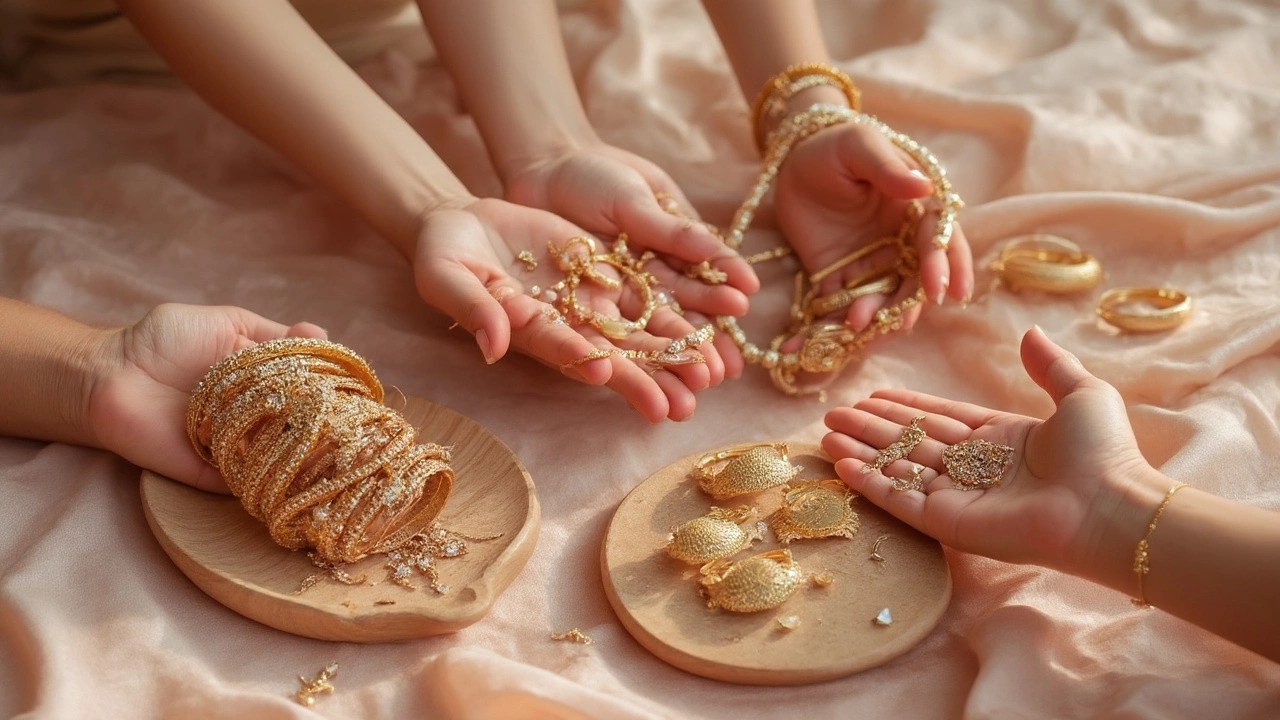Did you know that India's gems and jewelry sector contributes about 7% to the country's GDP? That's huge. But what's even cooler: more and more people—yes, people sitting at their kitchen table—are carving out careers by making and selling jewelry right from home. You don't need a factory, a big fat investment, or even a celebrity connection to get started. All you need is a bit of creativity, some solid planning, and a smartphone that takes decent photos. So, if you've been eyeing those handmade earrings at pop-ups or scrolling through Instagram wishing you could sell your own designs, you're definitely not alone. Let's talk about how you can actually make it happen.
Finding Your Jewelry Niche and Style
You can't sell to everyone—and you shouldn't try. Instead, think about what kind of jewelry excites you most. Is it traditional kundan, modern minimalist pieces, quirky beaded bracelets, or upcycled junk jewelry? In Mumbai’s huge market, it pays off to carve out a style that feels authentic to you and stands out. For instance, look at home-based brands like The Trinket Tales or The Loom (real Indian Insta stores) who've become fan favorites because they don’t try to make something for everyone—they stick with a strong signature.
Identify your niche by checking out what’s trending on social platforms like Instagram and Pinterest. Indian millennials love layering necklaces but also crave unique one-offs. Research the gaps: do you see a shortage of affordable temple jewelry? Are people asking for eco-friendly options? Use online surveys, browse marketplaces (like Etsy, Amazon, and Meesho), or even chat with friends about what they'd actually wear.
Once you spot a direction, experiment with materials. If you want to start lean, begin with artificial or semi-precious stones, which save money and are easier to source. Here’s a fun fact: the most popular home-grown jewelry brands in India started off with basic beads and threads they picked up from local stores in Zaveri Bazaar, not from expensive suppliers. You too can start small—don’t buy kilos of material at first, just enough to create samples. It’s common to start with as little as ₹2,000-₹5,000 for base materials.
Don’t forget about your branding. Strong names like ‘Chumbak’ or ‘Pipa Bella’ are memorable and hint at the style of the jewelry—you might want to brainstorm catchy ideas that reflect your vibe. Simple packaging, like handcrafted pouches or reusable boxes, gives your pieces an instantly professional look and taps into India’s love for pretty, practical gifting.
Setting Up Your Home Studio and Sourcing Supplies
This isn’t about turning your living room into a full-blown factory. Most successful home jewelry businesses started on a kitchen table or a spare corner. All you truly need: a clean, well-lit surface, a couple of trays, and proper storage for supplies. Natural light helps, especially for product photos. Organize small parts in transparent boxes or old tins—nobody wants to spend an hour untangling silver chains when inspiration strikes.
Sourcing materials is part research, part hustle. Mumbai has gems like Crawford Market, Zaveri Bazaar, and even Bhuleshwar for bulk beads, imitation gems, silver wire, and findings (clasps and hooks). If you're not in Mumbai, search for local vendors or reputable online suppliers. Amazon India, Beadsnfashion, and even Instagram shops sell everything from seed beads to kundan settings. Always ask for samples and compare prices before locking in a supplier. A quick tip: suppliers often offer discounts if you mention you’re starting out. Negotiation is expected.
You’ll need some basic tools: pliers (round nose and flat versions), cutters, measuring tape, glue, tweezers, and wire. Don't waste money on expensive gadgets unless you're sure you’ll use them—watch YouTube DIYs or Skillshare classes to see the must-haves. For traditional jewelry, extra items like glue guns and embossing molds are handy. If you go for precious metal work, specialized kits exist but expect a higher initial cost.
Set up your work surface with clear lighting and a dust-free mat. Arrange your tools on hooks or in baskets you can easily reach. Trust me: a little setup makes production much less chaotic.
For packaging, avoid one-use plastics. Custom paper boxes, cotton pouches, or small baskets work well and make your brand feel premium. Wholesalers in Mumbai and online shops can customize packaging with your logo for surprisingly little cost—and customers really do love share-worthy unboxing.

Crafting and Pricing Your First Collection
This is where the fun (and also the frustration) kicks in. Start by creating 10–15 signature pieces that capture your chosen style—maybe a matching earring and necklace set, metallic bangles with Indian motifs, or beaded bracelets with charms. Take your time to ensure each is wearable and safe—no sharp edges, faulty clasps, or cheap coatings that wear off after one wear. Early feedback counts: ask friends or family to try your creations and listen closely to what they say. Do they itch? Break? Look cheap? Polish what you can based on their feedback.
Then comes pricing, which honestly makes most new sellers nervous. Here’s how a lot of Indian home-based jewelry makers figure it out:
- Add up the cost of materials for each piece (beads, chains, clasps, etc.).
- Count your time. A good starting rate is ₹50–100 per hour of labor, depending on your skill.
- Factor in packaging, transport, listing fees (if you use online platforms), and a markup—usually 30–50% for jewelry, sometimes higher for complicated designs.
- Be honest: Would you pay that amount for this piece? A little market research goes a long way. Check similar listings on other home-grown brands to see if your price makes sense for Mumbai’s audience—or wherever you plan to sell.
Pop quiz: Do customers care about the material? Absolutely. If you use hypoallergenic findings, genuine silver, or eco-friendly materials, call that out in your product descriptions. More and more Indian buyers are looking for sustainable fashion now.
Take crystal-clear photos of each item, ideally in natural light and from three angles. Show how the piece looks when worn (ask a friend to pose). If you're not confident with a DSLR, most modern smartphones do a great job—but take time to clean your lens and try simple editing apps like Snapseed or Canva to enhance color and clarity.
Create a simple catalog—a folder or PDF with images, prices, material details, and your logo—to create buzz among your early buyers. This is what you'll use to share on WhatsApp groups, Instagram stories, or with your first wholesale customer.
Getting Your First Customers and Selling Online
Between 2023 and 2025, India’s online jewelry market grew by nearly 20%—so digital selling is where the magic happens. Your homemade jewelry could reach buyers in Pune, Patna, or even Paris. But it takes more than posting photos and hoping for likes.
First, decide your launch pad. Instagram is still the number one platform for selling jewelry in India, follow closely by Facebook and WhatsApp. Create a business account with a catchy name, add a high-quality logo, and fill your bio with keywords like handcrafted, Indian jewelry, or eco-friendly. Post photos, production reels, progress shots, and behind-the-scenes videos. Engage daily: reply to comments, ask questions, hold quick polls. Early fans love feeling like they're with you on the journey.
Don’t ignore WhatsApp—it’s still how a lot of people shop! Send your catalog to select friends, family, and neighbors, asking them to share in their circles. Offer them a small discount or a freebie for referrals (think a simple beaded bracelet or free shipping).
If you want to move beyond social selling, build a mini-storefront. Use platforms like Shopify, Wix, or Instamojo, which are user-friendly even if you’re not techy. For even less technical hassle, list your items on Amazon India, Meesho, or Etsy—they charge fees, but you tap into a ready-made audience. Just be prepared to manage shipping across India.
Here’s an insider trick: join pop-up exhibitions or flea markets, even small ones in your area. The direct feedback, instant cash, and exposure are invaluable. Mumbai’s Colaba market or Bandra pop-ups are full of sellers who started from home and went on to open shops after gaining fans locally.
Offer cashless payment options—UPI, Paytm, Google Pay—since few people want to deal with cash these days. Make returns simple and build trust with clear policies.
| Platform | Features | Average Commission |
|---|---|---|
| Instagram/Facebook | Direct messaging, story polls, no fees, requires manual payment | 0% |
| Meesho | Simple listing, shipping handled by platform | 10-15% |
| Amazon India | Large audience, brand credibility, complex setup | 12-18% |
| Etsy | Reach global buyers, payment in USD | 5% + ₹15/listing |
| Shopify/Wix | Custom website, subscription fees | 2-4% + ₹1,500/mo |
Small brands like Bhura Craft or Shreejaa Jewels (look them up!) proved you don't need a marketing degree—you just need consistency, honest selling, and quick responses to DMs. Customers trust brands with real faces more than faceless corporates.

Legal, Financial, and Growth Essentials
This is the part most first-time jewelry entrepreneurs skip—don’t. Registering your business as a sole proprietorship is easy and only costs a few hundred rupees at a local CA’s office. Even if you start out super small, having a GSTIN (tax registration) makes it easier to buy supplies, list on bigger platforms, and build trust. Plus: some payment gateways require it. If you sell only within Maharashtra and keep it below ₹20 lakh revenue per year (as of July 2025), GST registration is optional—but it’s good to plan ahead for growth.
Set up a separate bank account for your business to make tracking sales and handling taxes so much easier. Keep digital records of all expenses—even if it’s for a packet of beads. Try apps like Vyapar or Zoho Books for quick accounting. When payments start rolling in, set aside 10–20% for future supplies or emergencies, and pay yourself a fixed monthly ‘salary’ from profits instead of dipping into sales money as you go.
Brand your packaging—add small thank you notes, stickers with your handle, or discount codes for next purchase. Unboxing is big in online shopping, and the little touches really matter. Consider collaborating with other home-makers, like local saree sellers or artisanal soap brands, to create festive hampers. You split marketing costs, reach wider audiences, and make festivals like Diwali even more profitable.
Stay sharp by joining Facebook groups, WhatsApp communities, or workshops for jewelry makers. These are goldmines for finding out about new suppliers, price hikes, trends, and even bulk orders. Remember, every successful business goes through slow months. Plan in advance for seasonal dips by working on new collections or learning better marketing tricks.
If you want to scale, look into tying up with boutiques, gift shops, or curated marketplaces. Email smaller stores in your area your catalog or samples. Wholesale margins are lower, but the order values are much higher, which means less time spent hunting for individual buyers.
The most important thing? Stick with your unique voice. Anybody can find beads and wire, but only you can tell your story through your jewelry. Whether it’s quirky Mumbai-themed charms or subtle office-wear pieces, customers remember—and keep coming back for—authenticity.
So yeah, starting a jewelry business from home in India is more than possible—it’s happening as you read this sentence. Be patient, keep learning, and who knows? Maybe next year, someone’s reading about you as inspiration. Jewelry business success truly starts at home.



